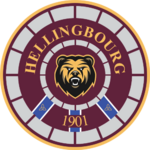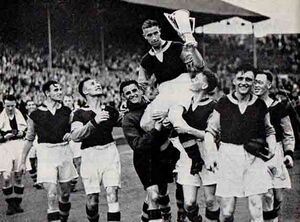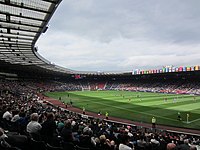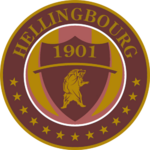FC Hellingbourg
 | ||||
| Full name | Football Club Hellingbourg | |||
|---|---|---|---|---|
| Nickname(s) | L'Ursas (The Bears) Les Loyalistes (The Loyalists) | |||
| Short name | HEL | |||
| Founded | 9 September 1901 as Saint Barthélemy | |||
| Ground | Stade NorteBanque | |||
| Capacity | 40,000 | |||
| Owner | Dupey Sports Group | |||
| Chairman | Iltut Ropars | |||
| Manager | Marcus Melgaard | |||
| League | Liga Premiére | |||
| 2018–19 | Liga Premiére, 8th | |||
|
| ||||
FC Hellingbourg is a professional association football club based in Berghelling, Midrasia. The club currently competes in Liga Premiére, the highest tier of Midrasian football. Hellingbourg have won two major trophies in their history, claiming the Copa de Mydra twice in both 1954, after defeating FC Mydroll on penalties in the final, and in 2020 after defeating Olympique de Lotrique 1-0.
Founded in 1901 by Reverend Estienne Aubert as FC Saint Barthélemy, the club was set up as an attempt to counter another team from the city, Vaelleniana KF who at the time only allowed native Vaellenians to play for their team. By contrast, Hellingbourg only allowed Orthodox Alydian descendants of Midrasian settlers to play for their team. Hellingbourg spent much of their early years in Liga 2, only gaining promotion to Liga 1 in 1944. For most of their life in Liga 1 the team remained mid-table, though in recent years they have finished as high as 5th place, earning qualification to the Asuran League.
The team play their home games at the Stade Aubert which is branded the Stade NorteBanque for sponsorship reasons. The stadium has a capacity of 40,000 and is located in the south-west of the city of Berghelling. The team have a large following from the city of Berghelling and the wider Vaellenia region. Fans of the club are primarily made up of the descendants of Midrasian settlers who came to Vaellenia between the Fifteenth and Seventeenth centuries.
Fans of Hellingbourg have a long-standing rivalry with cross-town rivals Vaelleniana. Matches between the two sides are known as the Berghelling derby and in the past have been some of the most violent clashes in Midrasian football, with both sets of fans embroiled in sectarianism rooted within the makeup of each fan base. The club also has a minor rivalry with Skaer Thiaric another team from the Vaellenia region.
History
FC Hellingbourg was founded in 1901 in the city of Berghelling, then known as Hellingbourg. The team was originally known as Saint Barthélemy, taking its name from a local church, however its name would be changed to Hellingbourg in 1904. At the time within the city and surrounding regions, a number of established clubs already existed, however by far the largest and most successful was Vaelleniana KF which was notable for only allowing men of native Vaellenian heritage to play for the club. The success of the club within the regional divisions angered much of the Midrasian settler community within the city, which long pushed for a team to challenge Vaelleniana's dominance. On the 9th of September, Reverend Estienne Aubert posted a notice outside of his church located within the outskirts of the city calling for volunteers for a new football team. However, this new team was limited only to players of Midrasian descent and of the Orthodox Alydian faith in a move made to directly challenge Vaelleniana, but also to provide a sporting club specifically for this group.
Upon its foundation, Hellingbourg was entered into the Vaellenian regional division where they performed amicably. During their first game against Vaelleniana however, the team lost 5-1, though were able to snatch a 0-0 draw the following year. Upon the creation of the Midrasian Football League, Hellingbourg were placed into the second tier, whilst Vaelleniana was fast-tracked into Liga 1 due to their dominance of Vaellenian football. Nevertheless, the Vaellenian regional cup continued to operate during this period meaning both teams continued to regularly play against each other. Hellingbourg first victory in the tournament came in 1909 when they defeated Vaelleniana in the final 2-1. Throughout the life of the Vaellenian regional cup, Hellingbourg would win the tournament a total of 13 times, second only to Vaelleniana who would win it 32 times.
Hellingbourg finally gained promotion to Liga 1 in 1944 after winning Liga 2 the previous season. Though the team struggled with a relegation battle throughout the majority of the season, the team proved able to stay up after defeating Wincaestre Town in the final game of the season. After several years of low league finishes, the club's fortunes turned somewhat under manager Cédric Ballouhey who guided the team to their best-ever league finish of 8th place in 1951. Gradual improvements were made to the team throughout Ballouhey's tenure allowing Hellingbourg to move further up the league. One of the most important and controversial changes made under Ballouhey's tenure was the decision to eliminate the religious and ethnic requirements needed to play for the team. Though this brought considerable opposition from fans, the team's performances on the pitch soon silenced the dissenters. Hellingbourg's first signing following this rule change was Cuirpthean striker Seán mac Menamin who became the club's top scorer during a single season a year on from his signing. It was also under Ballouhey that Hellingbourg won their first and only major trophy, winning the Copa de Mydra during the 1953-54 season. The team defeated then favourites FC Mydroll on penalties after a 0-0 draw in regular time.
Despite hopes that Hellingbourg would build upon their success, the club failed to replicate their success. The team were knocked out of the 1954-55 Copa de Mydra by AC Fiorentina in the quarter-finals; and though they had a good first half to the season, they proved unable to mount a title challenge long-term, finishing the season in 3rd place. Ballouhey stayed on for 10 more years until a health crisis forced him into retirement. Without Ballouhey Hellingbourg were never quite the same and were relegated to Liga 2 in 1972.
Throughout much of the remainder of the twentieth century, and even into the early twenty-first century, Hellingbourg remained a yo-yo club consistently gaining promotion to Liga 1, only to be relegated back down within around three seasons. In 2004 however, the team was purchased by Dupey Sports Group, a Vaellenian based sports conglomerate notable for their investments in rugby union and ownership of companies such as Radix. Dupey provided a stable level of investment to the club, allowing them to gain promotion to Liga 1 and remain there whilst attracting key sponsors such as NorteBanque. Whilst this strategy saw minimal gains in the beginning, the stability that it brought has allowed the club to build year-upon-year and even eclipse its ailing rivals Vaelleniana. Out of the last seven matches between the two sides, Hellingbourg have won five and have regularly finished above Vaelleniana within the last three seasons. Hellingbourg also went on to win the 2019-20 Copa de Mydra after defeating Olympique de Lotrique 1-0 in the final thanks to an 88th minute penalty converted by Hugo Hunstad.
Stadium
Hellingbourg's current stadium is the Stade NorteBanque, previously known as the Stade Aubert. The stadium was originally named the Berghelling Municipal Stadium and was constructed in 1987 for that years' Mydran Athletic Games which was hosted in the city of Berghelling. Following the conclusion of the games, Hellingbourg took ownership of the stadium, renaming it after the founder of the club, Reverend Estienne Aubert. Over time a number of modifications were made to the stadium to increase its capacity and add hospitality seating. However, as the stadium continues to host athletic events, it retains its running track around the perimeter of the pitch, a matter of controversy for the club and its supporters who suggest the distance between the stands and pitch contributes to a poor pitch-side atmosphere.
In 2014 it was announced that through a deal between the club and primary shirt sponsor NorteBanque, the stadium would be renamed to the Stade NorteBanque. There was considerable controversy about renaming the stadium, with a number of protests against the decision. Nevertheless, many of the protestors relented when the club made the decision to freeze ticket prices for the next five seasons, a move which was partially financed by the new sponsorship agreement.
Badge and colours
FC Hellingbourg took its name from the Midrasian designation for the Vaellenian city of Berghelling. At the time of the club's foundation, Hellingbourg was the official name of the city, which would only be changed in 1985, albeit with considerable opposition. The club's main colour of claret is taken from both the maroon on the Midrasian flag, but also the Claret uniforms of the loyalist army during the Vaellenian Rising. However, the shade of claret used by the club has changed slightly in recent years, incorporating a more purple shade rather than brown. The club has always worn a shade of claret as its home jersey, usually with white shorts. The club usually uses white or navy for the colour of their away and third kits.
The club's crest has changed somewhat over the years, however has usually featured the bear emblem with which the club is associated. The previous emblem of the club also contained 13 stars which referred to the club's 13 Vaellenian regional trophies from the friendly competition which ran from 1900 to 1972. The stars were removed in the latest iteration of the logo, with many suggesting they were removed as they were constantly the butt of jokes that the club could not win any professional titles, so they displayed their informal ones instead.
Players
Current squad
Note: Flags indicate national team as defined under international eligibility rules. Players may hold more than one nationality.
|
|
Reserve squad
Note: Flags indicate national team as defined under international eligibility rules. Players may hold more than one nationality.
|
|



